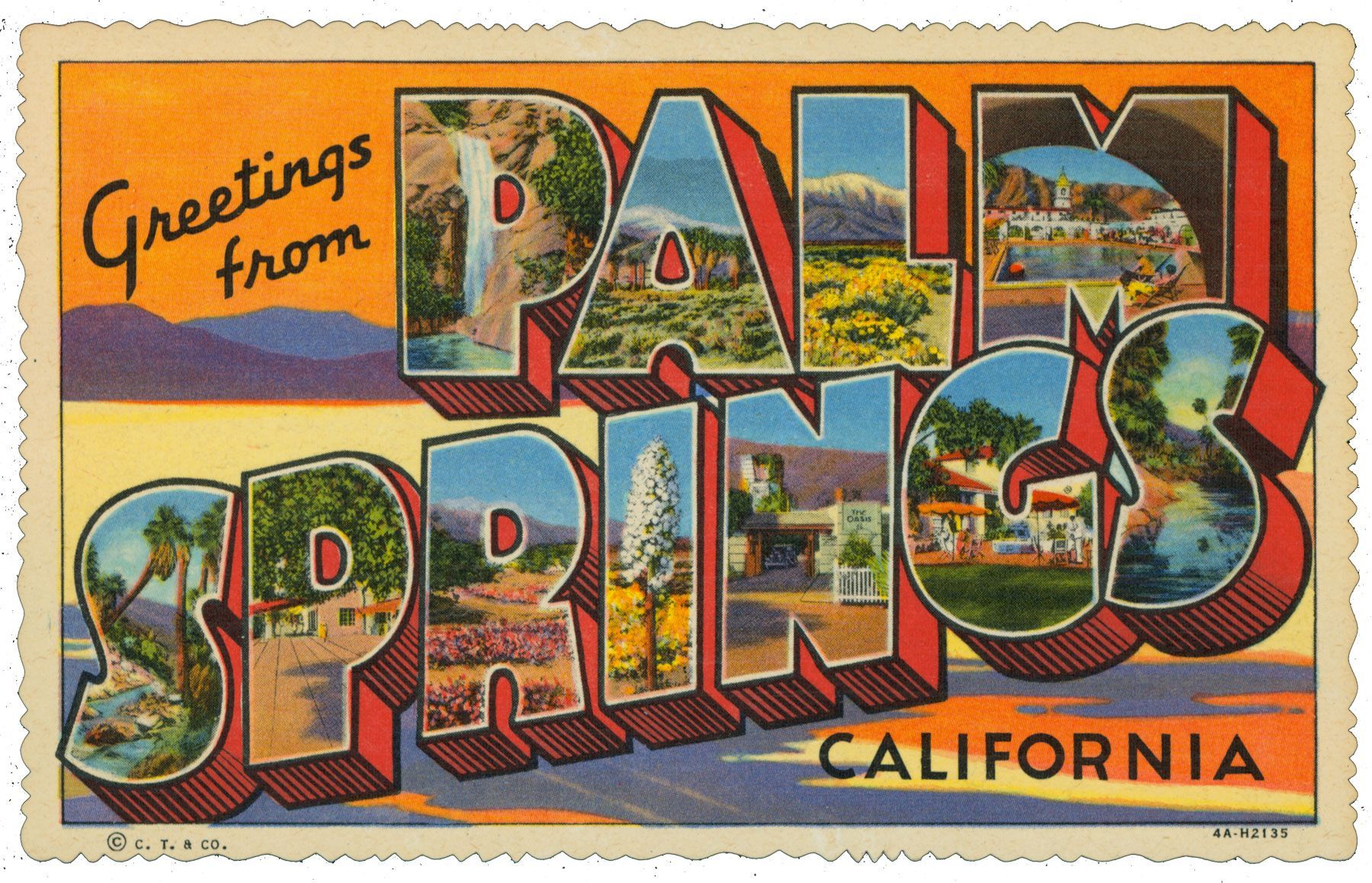Image credit: postcards of the Stephen H. Willard Collection, Courtesy Palm Springs Art Museum
I HAVE IN front of me a postcard of a photograph by Sebastião Salgado. There are two captions printed on the back, one says simply “Mali, 1985,” the other tells us it’s from the book In Our Time, The World As Seen By Magnum Photographers. It shows a woman and half a dozen children walking across a white expanse that we know must be a desert, but the sand is so white, and the image so high-contrast that they seem to be crossing a featureless void. Two of the youngest children are naked and we see their emaciated arms and legs and their misshapen bodies. The woman, the mother we assume, looks equally thin, but strangely elegant and dignified, her bare back exposed, a full-length train or head dress trailing behind her. We see none of their faces. The photograph is both beautiful and horrifying, arresting and shocking, and the most old-school teacher of artistic composition would think its elements were beautifully arranged.
Salgado has taken plenty of flak for making suffering look good. Susan Sontag accused him of “globalizing” suffering, inviting viewers “to feel that the sufferings and misfortunes are too vast, too irrevocable, too epic to be much changed by any local, political intervention.” Ingrid Sischy in a New Yorker essay on Salgado complained, “Beauty is a call to admiration, not to action.”
I bought that postcard a long time ago when I was first trying to educate myself about both photography, and deserts (I was working on a book titled Daytrips to the Desert), and it’s true enough that I didn’t feel motivated to intervene, politically or otherwise. Even at the time it seemed unlikely that I, or anyone with a grain of sensibility, would ever send this card through the post. Who exactly wants to find a postcard of emaciated children in their mailbox? What message could you possibly write to accompany it?
Taking and distributing photographs of other people’s suffering is clearly a morally dubious area. Converting these images into cheap mass-produced postcard seems even more beset with problems. What makes my postcard more troubling yet: It’s signed on the back by Sebastião Salgado. He signed it for me because I asked him to.
The fact is, along with my affection for many other dying forms, I still have a great fondness for picture postcards, whether reproductions of great works of art and photography or just vacation souvenirs. I wouldn’t say I have a postcard collection; I’d say I have a stash. I sometimes buy them when I see them, but sometimes I see them and I don’t, which is why I’m not a true collector — or deltiologist, to give it the fancy name. It must be said however, that a visit to an exhibition never feels complete unless I acquire a postcard or two.
¤
In Geoff Dyer’s brief, eloquent introduction to Understanding a Photograph, a collection of essays by John Berger, edited by Dyer, he refers to Walter Benjamin’s “The Work of Art in the Age of Mechanical Reproduction” and says, drolly, that it’s one of the world’s most mechanically reproduced essays. He also reminds us, if we need reminding, that many of us were first introduced to Benjamin’s ideas by Berger’s TV series, and then book, Ways of Seeing. Some of the earliest shots from the first episode show postcards being printed and machine-trimmed, the “aura” of the original artwork being thoroughly banished. The episode is now on YouTube of course, and once you get past Berger’s questionable hair and clothing choices it stills seems surprisingly fresh.
Benjamin’s essay asserted that the original work of art has an “aura” that any reproduction lacks. Benjamin certainly collected postcards as a young man, and in later life sent them to his friends. It is significant, though hardly intentional, that (at least by some accounts) the last words he ever wrote were on a postcard that he handed to Henny Gurland, who memorized the contents, and then destroyed the card:
In a situation with no way out, I have no choice but to end it. My life will finish in a little village in the Pyrenees where no one knows me. Please pass on my thoughts to my friend Adorno and explain to him the situation in which I find myself. There is not enough time to write all the letters I had wanted to write.
History doesn’t tell whether or not this was a picture postcard. History actually suspects that Henny Gurland may have made the whole thing up, still …
In Understanding a Photograph, Berger again writes approvingly of Benjamin in relation to the work of August Sander, and quotes him as saying, “Sander’s work is more than a picture book, it is an atlas of instruction.” He approves of Salgado’s work too. They’re friends. The book contains a remarkable photograph of the two of them walking near Berger’s home in France; “an alpinist coming down the local mountain noticed that Salgado was carrying a camera. ‘Would you like me to take a picture of you both?’ he asked.”
The image accompanies the transcript of an “unlaundered” conversation between Berger and Salgado. Berger says, “Part of the fanaticism of the economic system which we now call globalization […] it pretends that no alternative is possible. And it’s simply not true.” Salgado agrees, but isn’t sure what tactics a photographer should employ in the face of globalization. “Probably to do a film is a wrong way,” he says. “Probably to do a show of posters is not correct. But I sincerely want to know what is correct. Because, if it is correct, I believe that I must go and do it.”
Salgado famously became ill in the late 1990s and consulted a Parisian doctor who told him he wasn’t really ill but had simply seen too much death. And so he began the project, and now a book, titled Genesis, in which he purports to photograph those parts of the earth untainted by modern life. It might also have seemed like a way of getting away from the complaining of the likes of Sontag and Sischy, though critical response suggests that not everyone feels absolutely comfortable about being invited to look at indigenous people with penis sheaths, bare “indigenous” breasts, and bones through their lips. Would it also be churlish to remark that there’s actually quite a bit of death and “tainting” in the biblical Book of Genesis?
In any case Salgado’s images of the desert are surely blameless, and in the case of Monument Valley and the Grand Canyon, they’re absolutely stunning. My understanding is that Salgado uses a photographic technique that involves a digital image, then a negative, then further digitization so that the end results look like traditional, non-digital prints. I suspect these Genesis photographs will never be what Salgado is best known for, but looking at those desert images and then turning to Ansel Adams, Salgado sure looks like the boss to me.
¤
It’s very hard to take good pictures of the desert, which is to say it’s all too easy to take very bad pictures of the desert. Increasingly an unmediated image of the desert, or one that’s merely picturesque, doesn’t seem to be enough. We feel the need for intervention or conceptualization. We need, for instance, a Richard Misrach whose Desert Cantos are not simply asking us to admire the desert (though one does) but to consider the military and industrial desecration of the desert — and he too has been charged with aestheticizing.
There is currently a photographic exhibition at the Palm Springs Art Museum titled Secrets of The Sun, of work by Stephen H. Willard, not a very well known name, though his entire archive is there at the museum. He was described in a 2007 essay by Christine Giles as “The Ansel Adams of the Desert,” something of a tautology given the many desert photographs Adams shot. Certainly a portion of Willard’s work shares some of Adams’s values — deep tonal range black and white, flawless clarity, improbably dramatic skies, classic composition, a general (though not absolute) absence of humanity. There’s a wonderful photograph titled Upright Joshua Tree, Owens Lake, from 1945, that shows a single Joshua Tree isolated in vast sea of sand, nothing between it and the distant mountains, with the tree’s shadow falling at a strict 90 degrees across the earth. The image contains a stature and a kind of mystery that not all Willard’s work has. His black and white desert photographs — dunes, palm trees, desert tracks — are invariably beautiful and noble, but sometimes just a little dull.
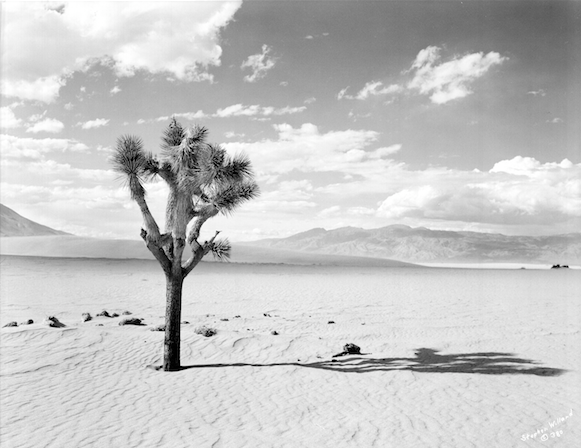 Photo credit: Stephen H. Willard, Upright Joshua on Owens Lake, June 3, 1945/2013, archival inkjet from film negative, (Willard No. 380), Palm Springs Art Museum, gift of Dr. Beatrice Willard © Palm Springs Art Museum
Photo credit: Stephen H. Willard, Upright Joshua on Owens Lake, June 3, 1945/2013, archival inkjet from film negative, (Willard No. 380), Palm Springs Art Museum, gift of Dr. Beatrice Willard © Palm Springs Art Museum
Rather more intriguing, and sometimes absolutely eye-popping, are his color pictures, although they’re not strictly speaking color photographs. Willard made large black and white photographic prints, and then “intervened” by painting on them with color wash and oil paint, creating unique objects, by way of a very elaborate form of hand tinting. Adams would have fainted away at the idea.
Willard also created hand-tinted postcards. The exhibition contains one or two images marked up with instructions to the printer, who sometimes evidently wasn’t very good at following instructions. The colorization is so extreme in certain cases that it looks like all concerned are anticipating the spread of major psychedelics in California. These, of course, do not look much like high art, at times they look simply kitsch, but the best of them are much more alive, and way more fun, than some of the solemn black and white studies.
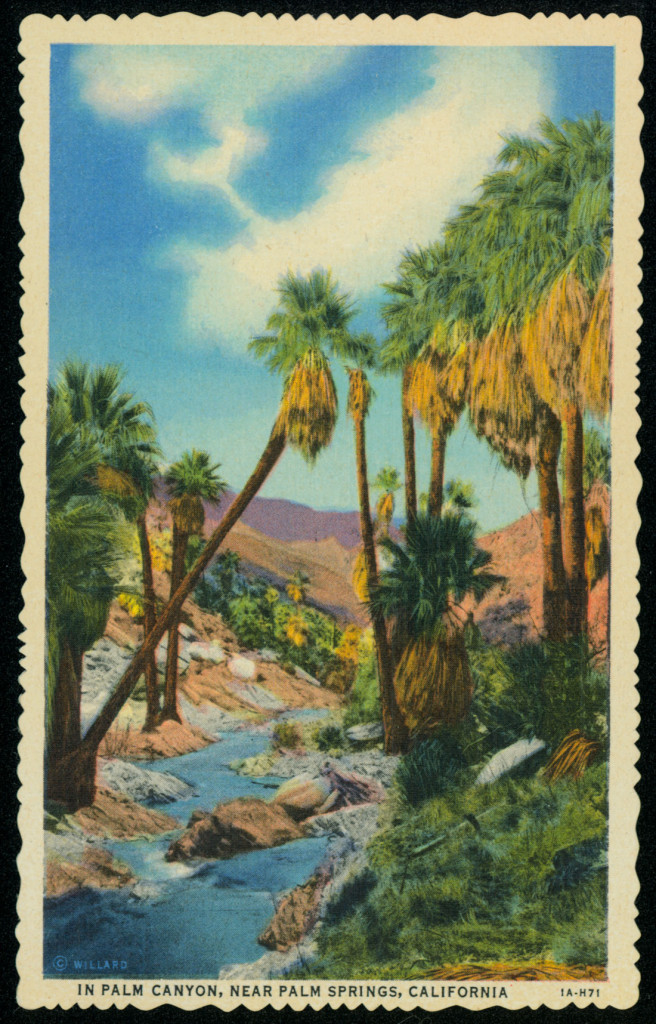 Postcards of the Stephen H. Willard Collection, Courtesy Palm Springs Art Museum
Postcards of the Stephen H. Willard Collection, Courtesy Palm Springs Art Museum
For all Willard’s artistry he was also a jobbing photographer. He had a studio and gallery in Palm Springs, photographed hotels and country clubs, was a publisher of postcards made chiefly, though not exclusively, from his own photographs. And seeing some of these in the exhibition, I realized with a happy shock of recognition that I have a few of these Willard postcards in my own stash. One of my favorites is titled Evening Colors on the Desert, with the saturation turned up to 11, and a caption that reads “In the golden hour of the sunset, the atmospheric colors combine with the brilliant hues of the Ranges to make a scene of almost unbelievable brilliance.” More than almost, I’d say. Some of Willard’s later postcards are labeled “A natural color reproduction from Kodachrome” but the printer still managed to give them a hand-tinted look.
Vintage Willard postcards can be bought easily online, and the lady in the gift shop told me that there are plans to print some reproductions for sale in the museum, but right now they’re only selling boxes of notecards with Willard’s images on them. There’s no catalog of the exhibition.
¤
Willard’s art photographs tend to show the desert in a pristine uninhabited state, whereas many of his postcards tend to show, and even promote, the desert as a place of hotels, swimming pools, country clubs. Inevitably the two are not mutually exclusive, and once in a while he will show a single house in the middle of the desert, thereby becoming an unwitting precursor of John Divola.
Divola seems to be a photographer whose time has come, demonstrating once again that there’s nothing like four decades of hard toil for creating overnight success. He recently had three exhibitions running simultaneously, in Pomona, Santa Barbara, and at LACMA, under the joint title As Far as I Could Get. The LACMA segment runs until July.
It would be reductive to regard Divola simply as a desert photographer but I think his best work, or at any rate all the work I like best, features the desert one way or another. Isolated Houses is a series of large format color photographs, also a book, showing single dwellings in the Mojave desert around Twentynine Palms, some inhabited, some not. The houses are small, simple, elemental, sometimes just made of cinderblocks. The light tends to be low and golden, and the desert looks gorgeous. Inevitably this is not pristine desert. Human presence is thinly spread but conspicuous and ubiquitous, and it would be possible for a certain eye to regard these isolated houses as blots on the landscape, but I don’t feel that’s Divola’s angle. In his pictures they fit perfectly. It must also be said some of them seem so insubstantial that they don’t look as though it’d be much of a job to clear them away.
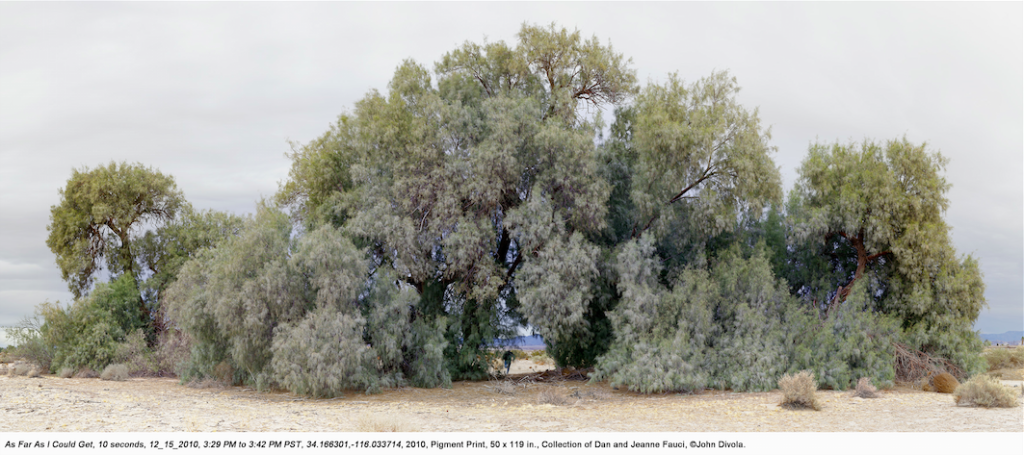
Another series, Dogs Chasing My Car in the Desert, consists of grainy blurry, black and white photographs, showing exactly what the title suggests, hounds running through the whiteness of the desert, in futile but spirited pursuit of the photographer’s vehicle. It’s hard to tell whether the dogs are crazed or just having fun; maybe both. They have owners of course, and in some of the photographs, there’s the litter of human habitation — houses, trucks, fences —looking a good deal rougher and less attractive than the Isolated Houses.
The series As Far As I Could Get, which became the title of the three exhibitions, involved Divola setting his camera on a tripod, using a 10-second delay, and then running directly away from the lens, until the shutter fired and took his receding self-portrait. The figure is at the center of the image but you see a lot of desert, and there’s a kind of oscillation: are you looking at the receding man, who is sometimes just a blur, or at the desert, which is essentially nondescript, and certainly not picturesque? All three of these Divola series depict the desert in a way that feels much more familiar and authentic than anything depicted by Willard, or Adams or for that matter Salgado.
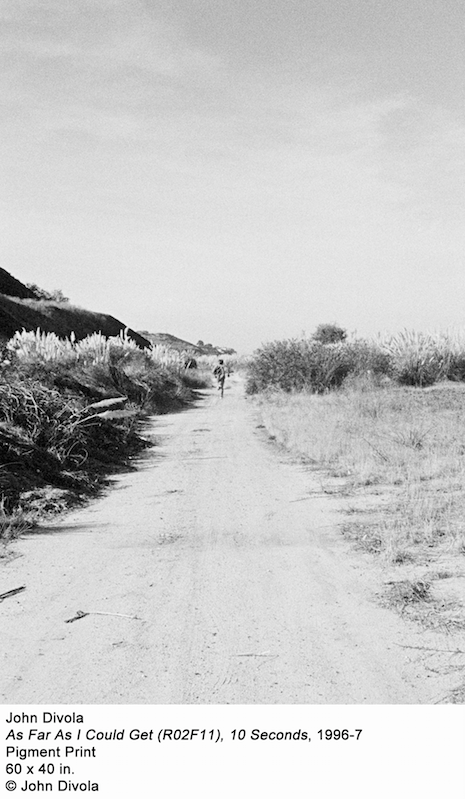
There is a fine, authoritative catalog to accompany the Divola exhibitions, but there are no postcards, and it struck me that I’d never seen any postcard of Divola’s work. I thought possibly this was some deliberate decision on his part, that he didn’t wish to have the “aura” mechanically removed from his work. In a brief email exchange, I asked him if this was so. He replied:
No, I have never gone about making post cards. A couple of institutions have produced cards over the years but I don't think I can recall any produced specifically as post cards. Even by the time I was young the postcard was already a nostalgic form. It just never appeared to be central to the discourse that interested me. I have nothing against it, it simply was not central.
Another grand theory bites the dust.
I was nevertheless delighted to come across an essay by Elizabeth Schambelan in Artforum about Divola’s Zuma series, for which he found an abandoned, and presumably isolated, house in Malibu, and intervened by spraying various designs on the walls and taking pictures of the results. The essay’s title is “Postcards From the Edge.”
¤
One of the purposes of the postcard has always been to provoke envy. The recipient remains homebound, stuck in their daily routine, while the sender is at leisure or on an adventure in some exotic place. This function has now been satisfactorily replaced by social media. Hell, there’s even the ecard. The purpose may be the same but the insult seems greater. Sending a real paper postcard required at least some small effort of selection, writing an address and a message, buying a stamp, and going to the mailbox — all desperately old technology no doubt, but nevertheless showing a small degree of attention and consideration that pressing “send” doesn’t quite have. The recipients also ended up with something they could stick on the wall: postcards are objects as well as images.
Researching this article, I was amazed to find that the USPS, which is obliged to keep records of these things, delivered about 4.5 million postcards last year, not at all bad for a dying form. Even so I remain pretty skeptical about a figure quoted by Jonathan Meades in a recent article in The Guardian, claiming that 100 million postcards are still sent in Britain each year. The article was plugging Meades’s latest project Pidgin Snaps, and titled “Why I went postal … and turned my snaps into postcards.” Meades, an English novelist, maker of TV programs, an architectural commentator, and at this point in some danger of becoming a national treasure in his own country, was moved to publish 100 of his own photographs, not in book form but as individual postcards that come in what he calls “a boxette.”
Meades confesses to being a deltiologist, and writes:
I have thousands of postcards but seldom send one, seldom receive one either […] Postcards are for collecting and scrutinising and delving into the lives of others. As bearers of greetings, brief messages, thanks and dutiful holiday clichés, they are ancient technology: pre-telephone, let alone mobile phone […] Yet they persist in a way that, say, public telephones do not.
He was, he says, inspired by Martin Parr’s Boring Postcards and Tom Phillips’ The Postcard Century, books featuring collections of postcards in which there’s been some conceptual intervention.
Meades’s results are fascinating if inevitably mixed. He makes no claim to be a “real” photographer, and few of these resemble “real” postcards either in style or subject matter. Few of them provoke much envy and, per John Divola, there’s nothing nostalgic about them. Put these in a rack in your gift shop and I suspect there would be few takers, which is a shame.
There are no deserts here, though there are some British and European equivalents: a stretch of blasted wasteland which we’re told is the Watt Tyler Country Park, a lone figure on a bench on a bleak stretch of sand, a blue van somehow magically dumped in the middle of a roadless Scottish peat bog. Meades is nothing if not an ironist and often the captions on the back of the cards seem only obliquely relevant to the images on the front. That figure on the bench is captioned “Latvian beach life.” Sometimes I think he simply tells lies. I’m pretty certain, for example, that the postcard of the faded blue caravan on the Isle of Lewis does not show where Gunther Minto wrote the last movement of Der Mesiterfelcher. I’m pretty certain Gunther Minto is Meades’s own dirty-minded invention. The recipient of a Pidgen Snaps postcard receives an oblique message from the “artist” as well as from the sender.
He also says, “There is not a person bias. The world of Pidgin Snaps, like the world of my films, is largely devoid of people. But people's interventions — shacks, cars, chimneys, roads, pylons, silos, landfill sites — are omnipresent.”
¤
As far as I can tell, “postcard theory” is fairly thin on the ground, and such as it is, often exists in relation to Jacques Derrida’s The Post Card: From Socrates to Freud and Beyond, 1987. In the section titled “Envois” he writes about a postcard that shows a medieval image of a seated Socrates writing down the words of Plato who stands behind him:
The card immediately seemed to me, how to put it, obscene. [...] For the moment, myself, I tell you that I see Plato getting an erection in Socrates’ back and see the insane hubris of his prick, an interminable, disproportionate erection [...] Imagine the day, when we will be able to send sperm by post card.
Well okay, I’ve imagined that now. Thanks, Jacques.
This stuff in turn moved John Phillips of the University of Singapore to write, in a paper titled “Reading The Postcard”:
The scene is a kind of cipher, standing in as the privileged example here for the primal (and thus secondary) scene of metaphysics itself and its singular deconstruction. The postcard seems to operate as a simple generator of extraordinarily complex aporias. The postcard depicts the aporia of metaphysics no less. But that’s not all. The postcard itself, its recto-verso, figure-text, and visible-intelligible doubling, already in its performative function as post card carries out the same scene, the scene it depicts and reproduces in iterations in principle ad infinitum.
I’m rather more persuaded by the words of another postcard collector, and of course photographer, Walker Evans. He collected for over 60 years and lectured on postcards at Yale, preferring that to talking about his own work. 700 of Evans’s postcards, out of a collection of some 9,000, were shown at the New York Met in 2009. I saw the exhibition and like a fool didn’t buy the catalog, which is now collectible and pricey. In it there’s a reprint of an essay Evans wrote for Fortune magazine to accompany a picture-spread celebrating the postcard, titled “Main Street Looking North from Courthouse Square.”
Evans writes:
In the 1900s, sending and saving picture postcards was a prevalent and often a deadly boring fad in a million middle class homes. Yet the plethora of cards printed in that period forms a sold bank from which we draw some of the most charming and, on occasion, the most horrid mementos ever bequeathed one generation to another.
He adds, “postcards are now in an aesthetic slump from which they may never recover.” He was writing this in 1948. Aesthetic slumps, like the death of certain forms, can sometimes be much exaggerated.
¤
Geoff Nicholson’s books include the novels Bleeding London and The Hollywood Dodo, and the nonfiction The Lost Art of Walking. He blogs about “food, sex, obsession, and the madness of the mouth” at psycho-gourmet.blogspot.com.
LARB Contributor
Geoff Nicholson is a contributing editor to the Los Angeles Review of Books. His books include the novels Bleeding London and The Hollywood Dodo. His latest, The Miranda, is published in October.
LARB Staff Recommendations
Photography’s Chattering Ghosts
Why do we trust, or distrust, photographs? What are the forces that exist behind these images and why do they command such authority?
At War with the Obvious, Obviously
Did you know LARB is a reader-supported nonprofit?
LARB publishes daily without a paywall as part of our mission to make rigorous, incisive, and engaging writing on every aspect of literature, culture, and the arts freely accessible to the public. Help us continue this work with your tax-deductible donation today!
